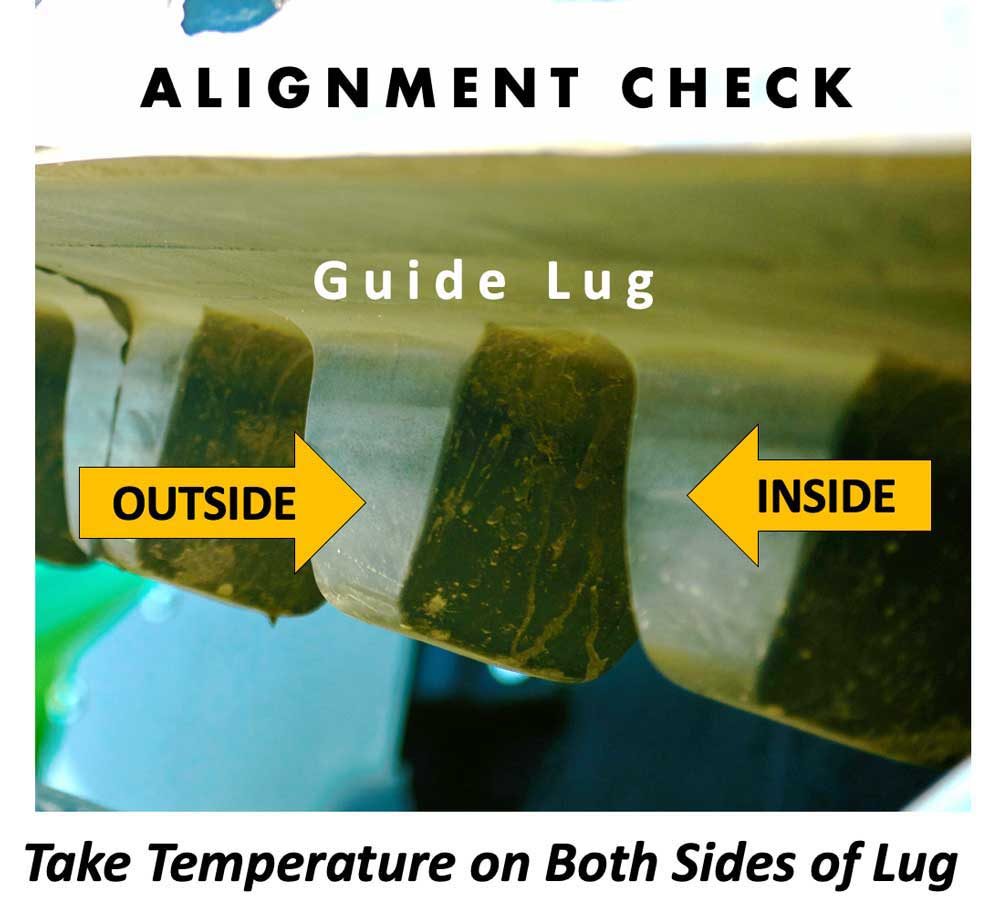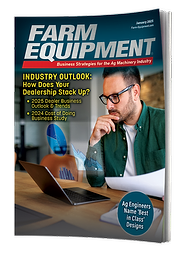Editor’s Note: This Q&A originally appeared in AG Track Talk to provide answers that farm equipment dealers have about farm track technology. This series features a trending question followed by an abridged version of the answers. For the complete answers, check out www.agtracktalk.com
Question: How do you check an ag track’s alignment?
Rob Schultz, Marketing Communications Americas, Continental: To start, here are some basic definitions:
- Alignment – Term referring to the mutual parallelism of the elements of an undercarriage, especially the drive wheel, idlers, and bogies. Also, the mutual parallelism of paired undercarriages. Alignment is important because it affects the tracking of the track.
- Misalignment – A condition in which the various elements of an undercarriage (especially the drive wheel, idlers, and bogies) are not “in line,” or are not mutually parallel. Misalignment can result in poor tracking.
- Tracking – A term referring to a track’s propensity to move laterally on its undercarriage. Typically, “good” or “proper” tracking is achieved when a track does not exhibit a propensity to move in either lateral direction. Conversely, “poor” tracking generally implies a condition in which the track does exhibit a propensity to move in a given lateral direction, and therefore “scrubs” its guide lugs against one side of the guide lug groove. Tracking is controlled through alignment, track tension and the internal construction of the track itself.
Before doing fieldwork, we always recommend inspecting track and undercarriage components to ensure there is no obvious damage or blatant alignment issues. Visual indicators of misalignment include the following:
- Guide/Drive Lug Chunking & Chipping
- Side Guide/Drive Lug Abrasion
- Lug Wear
Another indicator of misalignment, when driving the machine, is vehicle vibration.
To test for misalignment or poor tracking, another method is to perform a temperature check. Using an infra-red temperature gauge, you simply check differentiation in guide lug temperature from one track to the next.
To take an accurate track temperature check, we recommend the following:
- Run tractor 5-10 minutes with implements planned for use, making sure lugs are properly lubricated with graphite/talc powder at roading speed.
- Take temperature on both sides of Lug, noting variations
- If variance between lug sides is in excess of 20 degrees, that would suggest track is out of alignment.
It is important to re-run equipment after one side of machine is tested — that will prevent lugs from cooling down, providing inaccurate reading.
As always, we recommend you discuss all findings from above test procedures with certified ag track dealer, not only to confirm misalignment, but also to provide next steps on how to correct.
Lastly, overheating of the tread lugs and carcass can be caused by roading at high speeds, for long durations, under heavy loads; also influenced by high ambient temperatures and uneven road surfaces. Once overheated, the internal rubber loses physical properties and lessens the track’s ability to resist general wear and tear. In order to avoid track damage due to overheating, the customer should follow the vehicle manufacturer operator instructions.
In short, proper maintenance coupled with above pre-field checks can not only reduce downtime, but also play key role in attaining maximum track life.
Eric Halstead, Eng: Rubber Tracks Technical Expert/Agricultural Products, Soucy Track: These days, we can find track systems on many different type of farm equipment — tractors, carts, planters, sprayers, etc. One of the most important verifications on any track system is the alignments of the tracks. We all know that a faulty alignment will bring many issues and affect the durability of multiple components including the wheels, the idlers, the bearings, and the rubber track itself.
Alignment of tracks must be done on regular basis, even on new vehicles, as there is a lot of factors that could induce misalignment. Let’s start at the beginning.
A well designed track will have proper combination of cables and steel or fabric plies, accurately positioned in the belting, to make the track “neutral,” meaning the tracks will not have a natural tendency to turn neither left or right. The quality of the manufacturing process will determine the repeatability of this neutrality from track to track. A poor process will lead to movement of the reinforcement structures inside the track before curing and will greatly affect the track self-alignment behavior.
The track system geometry and dynamic movement will also influence the alignment of the tracks. Things like the shape of the wheels or the sprocket, the rigidity of the frame, the spacing of the components, the tensioner design, will all play a role in the ability of the track to be easily aligned and stay aligned over time.
Other factors will influence track alignment, and are more variable. They will change from one vehicle to another, varying with load on the axles, road conditions, implement being pulled, etc. For example, a heavily loaded axle will tend to create camber on the axle, and the track systems may no longer be perfectly perpendicular to the ground, creating a movement of the track outward. The track alignment system is used to compensate this kind of situation.
On most vehicles, there is an adjustment system to align the tracks. Two types of alignment systems are the most common: Rudder & Toe-In Toe-Out.
The Rudder type is a system that will pivot only the front axle of a track system and force a longer perimeter on one side of the track which will normally push the track toward the short perimeter side.
A Toe-In Toe-Out alignment system is different. The entire undercarriage can be pivoted to compensate for other factors. For example, if a vehicle is heavily loaded, and the rear tracks tends to move outward, the undercarriage can be pivoted outward, in order to minimize the friction of the drive lugs or guide lugs on the support wheels. This is a toe-out adjustment.
Both systems work fine, but the toe-in/toe-out approach could affect the vehicle on both sides, and it is preferred to make symmetrical adjustments whenever possible to avoid having one corner of the vehicle with a strong toe-out and the three other corners toed-in. A neutral and parallel initial position is where the process should start, and small movement on both side should be applied until the alignment is reached.
There are only a few methods to determine if a track is misaligned. The most popular and efficient is by measuring the temperature of each side of the guide lugs, determining a differential temperature. The friction created by a misaligned track will make the side of the guide lug increase in temperature, while the other side will stay cooler. An infrared temperature measurement gun is the easiest way to measure lug temperature and can be purchased anywhere.
The steps for measuring lug temperature are as follows:
- Configure the vehicle as it will be used, including load on axles. Test should not be done in wet conditions.
- Apply lubricant on the guide lugs before starting. It could be talc powder, graphite powder or simply just dry dirt. This will prevent the rubber lugs from sticking to the support wheels.
- Drive 5-10 minutes on a dry road, typical of the standard vehicle use. Drive at normal roading speed.
- Stop the vehicle and measure inward and outward sides of drive lugs. We recommend that each axle is done in separate test, as the time to measure would be getting longer and the side of the lugs will start cooling off, affecting accuracy of measurements. Note the results.
- If one of the two sides present a temperature higher than 20°C (35°F) from the other side of the lug, it means the alignment is not good. For example, if the outward side is hotter than the inward side it means the track is moving outward and should be corrected accordingly.
- Repeat for the other axles.
Remember that this procedure has to be repeated when the usage conditions of a vehicle are changing significantly, especially on the rear axle. A proper alignment will insure a long life out of your tracks and lower the risk of failure in the middle of a field.
If you have more questions, you can contact Soucy experts, they will be happy to provide details on the alignment procedure.









